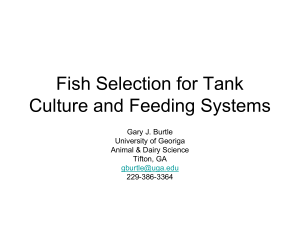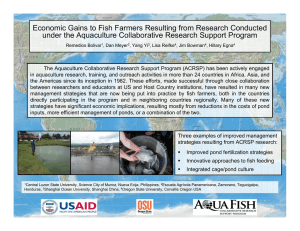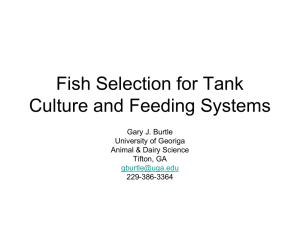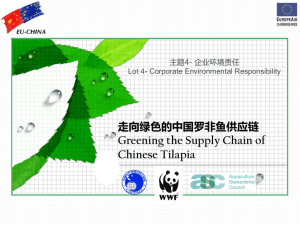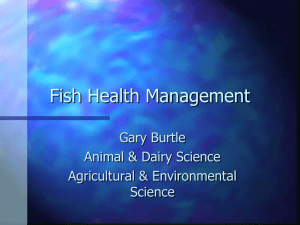Fish Feed as Nutrition
advertisement
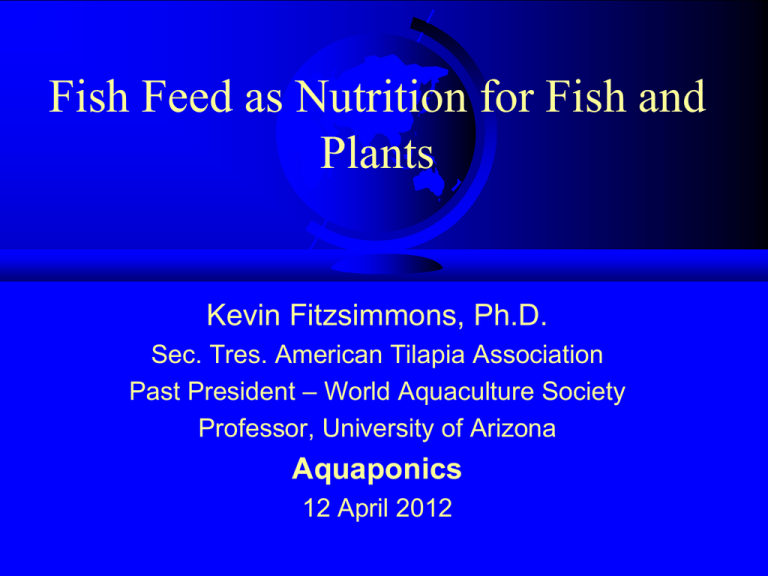
Fish Feed as Nutrition for Fish and Plants Kevin Fitzsimmons, Ph.D. Sec. Tres. American Tilapia Association Past President – World Aquaculture Society Professor, University of Arizona Aquaponics 12 April 2012 Contents Nutrition Ingredients and Formulations Manufacture and Preparation Storage, Handling, and Feeding Methods Nutrition and feeding behaviours Tilapia are omnivores (eat lots of things) Especially capable of consuming decaying vegetable matter Long intestine Filter feeders (algae, bacteria, plankton) when young Need protein and balanced nutrition for rapid growth Maybe more cost effective to settle for moderate growth Feeding strategy Juvenile fish are especially good at filter feeding phytoplankton. Many hatcheries utilize greenwater culture Juveniles also filter feed on small zooplankters (especially crustaceans) Save money on juvenile feeds by partial nutrition from natural feed in juvenile ponds and tanks Tilapia nutrition decisions Natural herbivores and detritivores. Opportunistic feeders grazing on algae and bacteria in production system. Fry and fingerlings need high protein (50-40%) diet Growout needs lower protein (32-28%) diet “Organic” diets may be needed for “organic” buyers Compare FCR to decide most efficient diet Minimize fish meal in diet Use more soybean meal Utilize other grains treated with phytase Increase use of other by-product meals (meat and bone, blood, feather, poultry byproduct, brewers waste, etc.) Examine other locally available ingredients (rice bran, cassava leaf meal, etc) Tilapia Biology Long convoluted intestine. Digests complex organic matter Fry are filter feeders Adults are grazers Proteins Tilapia need balanced set of amino acids. Basic building blocks of proteins (and muscles) Ten essential amino acids (required) several more are supplemental Lipids Lipids are basically fats. Fish need a variety of long chain hydrocarbon fatty acids for proper growth Tilapia will also bio-accumulate lipids from consumed algae Remember organic chem? Found in many freshwater and marine algae, canola, walnuts, soybean, and flaxseeds Essential part of the nutritional requirement of almost all organisms Important in neural and cardiovascular functions Facts about fatty acids in other farmed fish Fatty acids can also be elevated in fish depending on feed ingredients Higher omega-3’s are expensive and will likely require higher price Tilapia - Moderate in PUFA’s: 0.387 g/100g raw 0.600 g/100g cooked Tilapia - Moderate omega 3 FA’s: 0.141 g/100g raw 0.220 g/100g cooked Source – USDA- ARS Lab Carbohydrates Needed for metabolic energy Carbohydrates are polymers of sugar. Common ingredients are corn, sorghum, rice Molasses is mostly sugar and water. Does not supply as much energy as equal mass of lipid (fat) Fiber Less digestible material to help move material though the intestines. Helps with micronutrients Vitamins and minerals Commonly supplied in “premix” Often available in natural production of ponds. Not critical for most semi-intensive fish farm operations. Very critical in intensive systems (cages, raceways) Pigments Salmon and trout feeds sometimes include ingredients that impart reddish or pink color to the flesh. Astanxanthin, canthaxanthin and beta-carotene are commonly used. These may be plant or algae extracts, or chemically derived. May also use whole algae as ingredient (Spirulina or Dunaliella) Yes, the same extracts and algae sold in health food stores, (which was not included in the scare stories) Binding agents Gums, agar, cooked starches, wheat and corn glutens, and other ingredients can be used for binding. Preservatives Ethoxyquin Anti-oxidants Goal is to avoid rancidity, loss of nutrients Attractants Fish oil, fish meal, and fish solubles are good attractants Ingredients and formulations Normally need high protein diets for young 40-50% Protein requirements drop as fish reach reproductive age. Lipid demand might increase with egg formation. 30-32% Growout diets only need 25% protein Manufacturing and preparations Pellet mill Compression pellet mill Feed mixed with water to dough consistency Moistened feed put into hopper, pushed down to auger screw Auger forces feed through the die head. Holes in die determine pellet width Knife blade cuts pellets to desired length Extruders Floating feeds Feed mixes with steam in barrel of extruder Cooks ingredients, improves palatability Gelatinizes starches Steam expansion and auger forces feed out of barrel with rapid expansion. Traps air in pellet, allows to float Meat grinders and pasta mills Bioflocs Deliberate culture of high density of phytoplankton and bacteria Storage Always keep feed as dry and cool as possible Avoids spoilage and rancidity of fats in diet Bags should be on pallets, off floor to allow air to circulate and slow pests (mice, rats, roaches, ants, from getting to bags Large amount can be stored in bulk in silos. Handling Reduce rough handling Crushed pellets form fines which are not consumed by fish. Fed by hand, blower, belts Conclusions Tilapia are omnivores But eating anything will not make you grow fast and strong Tilapia need balanced nutrition for rapid growth just like human children
